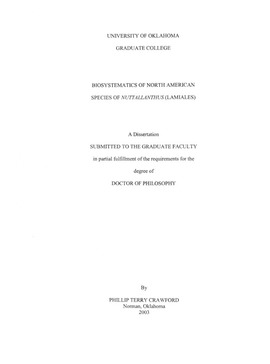| dc.contributor.advisor | Elisens, Wayne J., | en_US |
| dc.contributor.author | Crawford, Phillip Terry. | en_US |
| dc.date.accessioned | 2013-08-16T12:19:15Z | |
| dc.date.available | 2013-08-16T12:19:15Z | |
| dc.date.issued | 2003 | en_US |
| dc.identifier.uri | https://hdl.handle.net/11244/669 | |
| dc.description.abstract | The native North American toadflaxes comprise a morphologically-variable complex of herbaceous plants that have been collectively recognized as a section of Linaria (Linaria section Leptoplectron ) or a distinct genus (Nuttallanthus D. Sutton) and individually assigned to specific or varietal rank. High levels of intraspecific morphological variation and intergradation in the morphological characters used to distinguish among these taxa have led to diverse taxonomic treatments of the members of this group. This study represents the first use of enzyme electrophoresis to examine patterns of genetic variation in this species complex. Despite their wide geographic distribution and showy, fragrant flowers (seemingly adapted for insect pollination and outbreeding) the extent and distribution of genetic variation at the populational level was similar to that of narrowly distributed, autogamous species; a low level of detected heterozygotes suggested a high degree of inbreeding in these taxa. Field and greenhouse breeding-system studies indicated that individuals of all three species were entirely self-compatible and that the primary reproductive strategy of these taxa involved cleistogamy and self-pollination. No hand-performed cross pollinations among species resulted in the successful development of capsules and seeds, indicating that these species were reproductively isolated in areas of sympatry. Univariate and multivariate analyses of morphological characters measured from field-collected samples revealed significant morphological gaps among taxa and consistently separated samples into three primary clusters corresponding to the currently circumscribed species; strong and significant correlations between patterns of morphological and genetic variation were observed among populations and species. The observed morphological discontinuities separating groups in this genus and the close correspondence of extensive morphological and genetic gaps among these taxa is concordant with the observed cross-incompatibility among species; these results strongly support the recognition of three species in North American Nuttallanthus. Due to similar genetic divergence values among species, phylogenetic relationships in Nuttallanthus remain unresolved. Patterns of genetic and morphological differentiation within and among these species suggests a long history of reproductive isolation due to biotic and paleogeographic barriers to gene flow. | en_US |
| dc.format.extent | xii, 133 leaves : | en_US |
| dc.subject | Lamiales. | en_US |
| dc.subject | Linaria. | en_US |
| dc.subject | Biology, Genetics. | en_US |
| dc.subject | Linaria vulgaris. | en_US |
| dc.subject | Plant morphology. | en_US |
| dc.subject | Biology, Botany. | en_US |
| dc.subject | Plants Classification. | en_US |
| dc.title | Biosystematics of North American species of Nuttallanthus (Lamiales). | en_US |
| dc.type | Thesis | en_US |
| dc.thesis.degree | Ph.D. | en_US |
| dc.thesis.degreeDiscipline | Department of Microbiology and Plant Biology | en_US |
| dc.note | Adviser: Wayne J. Elisens. | en_US |
| dc.note | Source: Dissertation Abstracts International, Volume: 64-10, Section: B, page: 4712. | en_US |
| ou.identifier | (UMI)AAI3109064 | en_US |
| ou.group | College of Arts and Sciences::Department of Microbiology and Plant Biology | |
